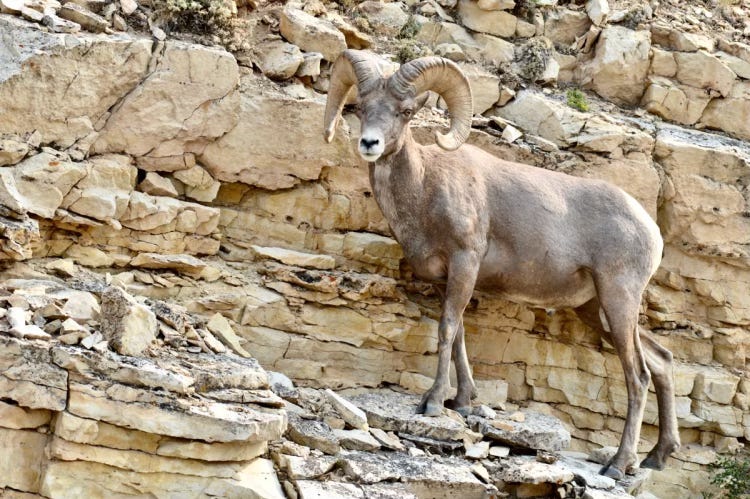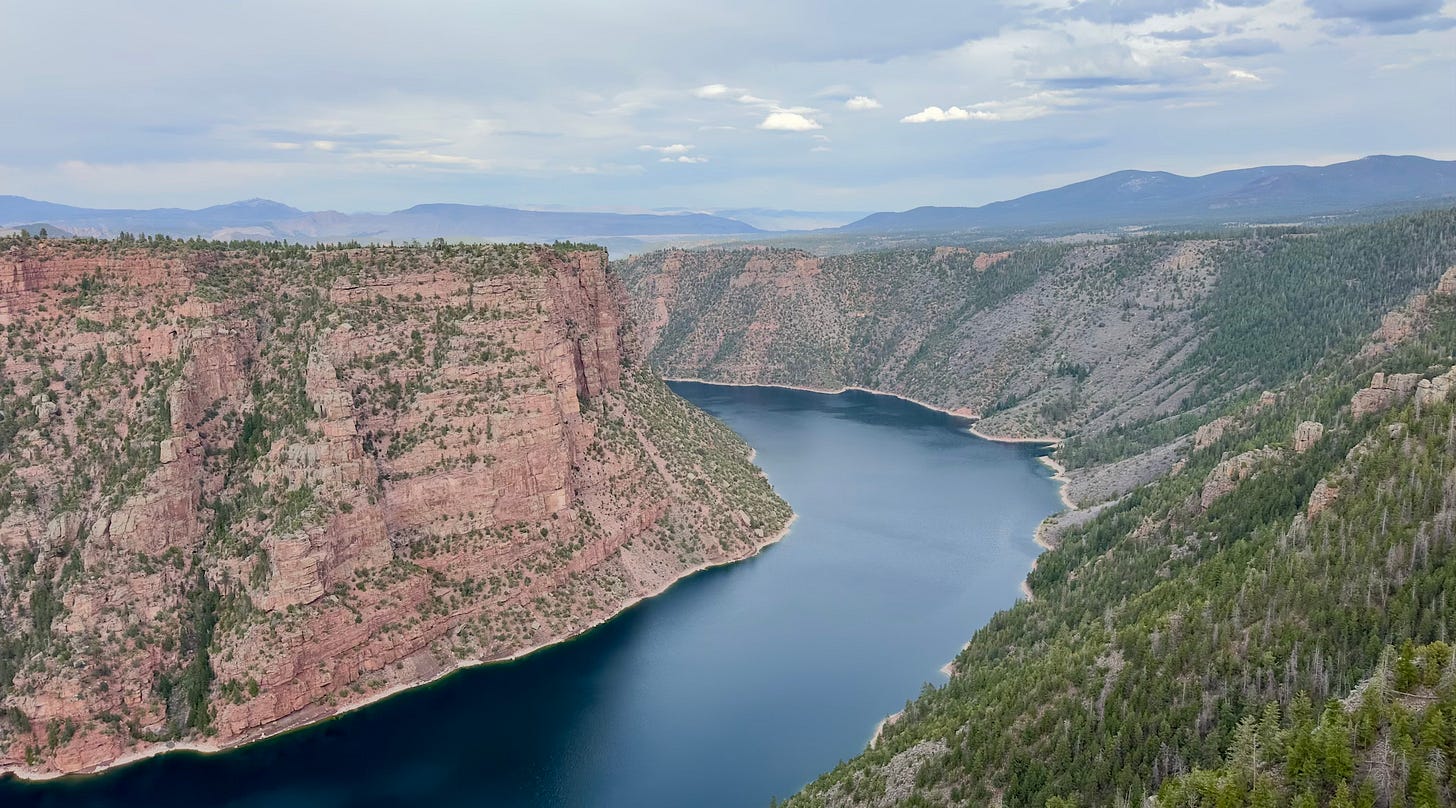These majestic bighorns are one sneeze away from extinction
And selfies are to blame for a rise in shark attacks.
By Dan Fletcher
Here is today’s audio edition!
Perched on the rim of eastern Utah's Flaming Gorge, I watch the afternoon light crawl across rust-colored cliffs. The 91-mile reservoir shimmers below, filling a canyon that was once prime habitat for one of the West's most iconic animals — the Rocky Mountain bighorn sheep.
What strikes me most about this landscape isn't what I see, but what I don't: big herds of bighorns that should be navigating these escarpments by the hundreds. Instead, I only encounter a few wary and scraggly sheep scratching out an existence up by the visitor center.

The fact that you can still see bighorns with some ease and regularity masks how rare they’ve actually become. The populations left are the tiny remnants of massive herds in the past. Before European settlement, as many as two million bighorn sheep roamed the American West. By the 1950s, that number had collapsed to around 25,000.
The story at Flaming Gorge mirrors this broader tragedy in miniature – complete extinction, followed by cautious restoration, devastating setbacks, and the fragile recovery we now witness.
Their downfall came in brutal waves: first, commercial hunting between 1850-1910, when "skull hunters" killed them by the wagonload without limits or seasons. Then came the double assault of domestic livestock – competing for the same winter grazing lands while simultaneously introducing devastating diseases. Mycoplasma pneumonia and scabies from domestic sheep decimated entire herds with a single nose-to-nose contact. The coup de grace was habitat fragmentation and fire suppression, which let forests encroach on the open escape terrain bighorns depend on to avoid predators. What had been a vast, connected population became isolated pockets too small to withstand disease, predation, or genetic bottlenecks.
By the time engineers completed Flaming Gorge Dam in 1964, the original canyon herds were long gone – ghosts of a wilder past. The area's first real restoration attempt came in 1983, when wildlife biologists relocated 19 healthy sheep from Wyoming's Whiskey Basin. Helicopter crews dropped them onto the mountains, followed by two dozen more the next winter.
Initially, it seemed like a success. Lamb numbers doubled, and by the late 1990s, several hundred inhabited the Flaming Gorge region across five loosely connected populations.
But beneath this apparent triumph, a biological time bomb was already ticking.
The greatest threat to bighorn sheep isn't habitat loss or predators – it's microscopic. Domestic sheep carry a pneumonia bacterium called Mycoplasma ovipneumoniae (or "Movi") that wild sheep have no immunity against. A single nose-to-nose contact with a domestic sheep or goat can devastate an entire wild herd.
That's exactly what happened at Flaming Gorge in 2009, when Movi found its way to one of the local herds. The first ewe died that fall. By spring 2010, entire nursery bands were found dead across the slopes. Wildlife managers made the heartbreaking decision to cull the survivors to prevent spread to other populations. Around 50 animals were lost.
Just three years later, another area suffered its own outbreak. Lamb survival plummeted from 35-40% to single digits. In four brutal winters, Flaming Gorge's total sheep population fell below 200, erasing a quarter-century of painstaking recovery work.
Today, Flaming Gorge hosts approximately 175 bighorn sheep — a number often celebrated in conservation reports but one that masks the herd's precarious reality. Wildlife managers know this population remains just one bad winter or disease outbreak away from collapse.
Wildlife agencies have gotten smarter about transplants, carefully screening all source herds for Movi before releases. They've equipped sheep with telemetry collars that signal when an animal dies, allowing rapid collection of remains to determine cause of death. And they've begun thinning encroaching pinyon-juniper woodlands that block the sheep's vital escape terrain.
But the core problem remains largely unaddressed. These herds need complete separation from domestic sheep and goats, habitat restoration at a landscape scale, and genetic connectivity between isolated populations.
Genuine recovery would require bold action, including:
Strict buffer zones keeping domestic sheep at least 12 miles from wild herds, enforced through fencing or grazing permit buy-outs
Habitat restoration measured in tens of thousands of acres, not hundreds
Regular genetic exchanges between isolated herds to maintain diversity and resilience
A shift in ambitions for how we define success — aiming for populations in the thousands, not hundreds
Beyond their charismatic curled horns and gravity-defying cliff leaps, bighorns serve as barometers for our commitment to genuine conservation. If we can't protect these photogenic, culturally significant animals that everyone claims to value, what hope exists for less charismatic species?
The bighorns of Flaming Gorge illustrate both the remarkable resilience of wildlife when given a chance and the half-measures that too often define our approach to restoration. As I watch the sun set over the ridge and head back to the car, I'm left wondering which story will ultimately prevail.
Quick links! 🔗
Researchers say selfie-seeking tourists are partly to blame for the rise in shark attacks. New data from PSL University published in Frontiers in Conservation found approximately 5% of shark bites are defensive reactions after humans poke, prod, or try to touch sharks — behaviors often encouraged by social media influencers. The study identified over 300 such incidents in records dating back to the 1800s. Marine biologist Professor Eric Clua notes the double standard in our attitudes toward wildlife: "People know the difference between a Yorkshire terrier and a pit bull, whereas they don't know the difference between a blacktip reef shark and a bull shark." His advice for shark encounters is refreshingly simple: "Don't touch. Just look at it."
Girl boss bonobos team up to take down males in the jungle. New research in Communications Biology analyzing 30 years of observations found that female bonobos form powerful coalitions to suppress male aggression, with 85% of group attacks involving females ganging up on males. Despite males being physically larger, females won about three-fifths of conflicts by working together — kicking, chasing, and screaming so loudly researchers "have to block [their] ears." Harvard behavioral ecologist Martin Surbeck says the findings challenge assumptions about power dynamics, showing that "male dominance is not evolutionarily inevitable." The research offers intriguing parallels to human societies, suggesting our primate cousins found strength in solidarity millions of years ago.








